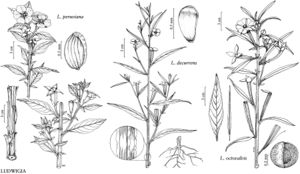Difference between revisions of "Ludwigia octovalvis"
Kew Bull. 15: 476. 1962.
imported>Volume Importer |
imported>Volume Importer |
||
| Line 198: | Line 198: | ||
|publication year=1962 | |publication year=1962 | ||
|special status= | |special status= | ||
| − | |source xml=https://xjsachs2@bitbucket.org/aafc-mbb/fna-data-curation.git/src/ | + | |source xml=https://xjsachs2@bitbucket.org/aafc-mbb/fna-data-curation.git/src/e39f0e846f172941159b2045254d62d10d9823f6/coarse_grained_fna_xml/V10/V10_225.xml |
|subfamily=Onagraceae subfam. Ludwigioideae | |subfamily=Onagraceae subfam. Ludwigioideae | ||
|genus=Ludwigia | |genus=Ludwigia | ||
Latest revision as of 10:31, 9 May 2022
Herbs (robust)or shrubs, herbs tap-rooted, often woody at base, with peeling bark. Stems erect to spreading, terete or sometimes ridged, 60–250(–400) cm, densely branched, densely villous to glabrate, especially near base. Leaves: stipules deltate, 0.5–0.8 × 0.6–0.7 mm, fleshy; petiole 0–1 cm; blade linear to oblong or oblanceolate, sometimes narrowly ovate, 0.7–14.5 × 0.1–4 cm, base tapered, margins entire, apex acute to acuminate, surfaces ± densely villous or strigillose; bracts not or scarcely reduced. Inflorescences open, leafy racemes, flowers solitary in axils, presentation often radial; bracteoles ovate, 3–8 × 1.4–4 mm, apex acuminate, attached near base of ovary. Flowers: sepals lanceolate to ovate, (6–)8–13 × 3–7 mm, apex acuminate, surfaces strigillose adaxially; petals bright yellow, fan-shaped, (5–)10–20 × 5–20 mm, apex sometimes shallowly notched; stamens 8 in 2 subequal series, yellowish white, filaments spreading, 4–6 mm, anthers oblong, 2.5–5 × 1–2 mm; pollen shed in tetrads or sometimes polyads; ovary cylindric, 4-angled, sometimes slightly twisted, 8–22 × 1–3 mm; nectary disc elevated 0.4–0.5 mm on ovary apex, 1–2.4 mm diam., with 4 white-pubescent sunken lobes opposite petals; style 2.5–3.5 mm, stigma capitate-globose, 1.8–3.5 × 2.5–3.5 mm, surrounded by anthers and pollen shed directly on it. Capsules cylindric to clavate-cylindric, subterete to ± 4-angled, 17–50 × 2.5–8 mm, thin-walled, irregularly dehiscent by 4–8 linear valves splitting from apex, short-villous, pedicel 5–25 mm. Seeds in several indistinct rows per locule, broad-cylindric with rounded ends, 0.6–0.9 × 0.5–0.8 mm, raphe inflated and nearly equal to seed body. 2n = [16], 32, 48.
Phenology: Flowering summer–early fall.
Habitat: Wet or moist places, along coasts, streams, ditches, swamps, often near disturbance or cultivation.
Elevation: 0–300[–2200] m.
Distribution
Ala., Fla., Ga., La., Miss., N.C., S.C., Tex., Mexico, West Indies, Central America, South America, s, e Asia (Burma, China, India, Japan, Thailand, Vietnam), Africa, Indian Ocean Islands (Comoros Islands, Madagascar), Pacific Islands (New Caledonia, Papua New Guinea, Philippines).
Discussion
Ludwigia octovalvis is perhaps the most widespread species of Ludwigia worldwide and exhibits a very complex pattern of morphological and ecological variation, correlated only in part with multiple ploidy levels; this complexity is reflected in its extensive synonymy. P. H. Raven (1963[1964]), P. A. Munz (1942, 1965), and others have proposed formal classifications to account for this variation, with mixed results and additional study using more powerful analytical tools is clearly needed in order to develop a more stable classification. In the absence of better understanding, and despite some correlated patterns of morphological and geographical variation on a global scale, this treatment does not recognize infraspecific taxa.
Jussiaea hirsuta Velloso, J. suffruticosa var. angustifolia Chodat & Hassler, J. velutina Kunze, and Ludwigia suffruticosa (Linnaeus) M. Gómez are later homonyms; these four names pertain here.
Selected References
None.
